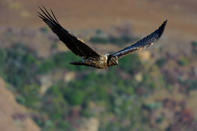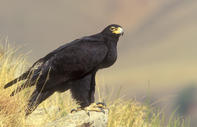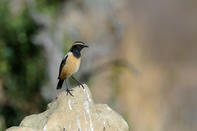Most Beautiful Sights of the Mountains
Forget about the things that grovel on the ground and lift your eyes to the heavens, from whence cometh the most beautiful sights of the mountains - the birds. I have given some details of the Lammergeier (Bearded vulture) in the preceding pages, but you have to see these great birds in flight to appreciate them.

While juveniles have dark, mottled plumage, adults have almost black wings and tails, with striking golden brown bodies. If you see one up close, the face is remarkable too: pale gold with a bright red ring around the eyes and a black mask, with the tell-tale 'beard' feathers hanging down from a stout, curved beak.
Legend has it that the Greek poet Aeschylus died when a Lammergeier dropped a tortoise, to try to crack it open, and it landed on the unfortunate man's head. The birds have favorite rocks called ossuaries (place of bones) which they use for dropping bones onto, to break open to get at the marrow. In the Bible the birds are referred to as ossifrages (bone-eaters).
Bird Books

Some bird books say the golden body colour of adults comes from rubbing against their sandstone roosts, but I cannot believe this. The colour is just too uniform, and many of them roost on basalt ledges anyway. When in flight the diagnostic features (apart from very large size and colouring) are fast, flight and a diamond-shaped tail. The more common Cape vulture has a stumpy, fan-shaped tail.
But don't ignore the vultures, for they are masters of the air, catching thermals with an aerial efficiency that makes every paraglider pilot drool with envy. The black eagle, with its distinctive white back cross is, however, the definitive bird of the Southern African mountains, being found just about wherever there are crags and dassies, its principle food.
In fact the distributions of these two species overlap almost exactly. If you go down the raptor hierarchy, the next most impressive bird is the jackal buzzard, so named because of its jackal-like cry, usually issued while the bird is circling high up in the sky. Thereafter come the falcons, mainly the swift and handsome lanner, and then the hawks - African goshawk, marsh harriers and black sparrowhawk particularly.
Other Common Birds

If you’re lucky, you will see wattled cranes in the moist grasslands of Mkhomazi, bald ibises on the Little Berg of Giant's Castle, as well as marsh owls on the summit. Grey-winged francolins, which local people variously call 'partridges' and 'pheasants', are pretty common throughout the grasslands.
About half their size is the shy common quail which bursts up almost at your feet in a whirr of wings and 'skree' alarm call, only to disappear into cover a short way off. Possibly the most conspicuous grassland bird is the orange-throated longclaw, a pipit-like species that favours tufty grass areas; it scratches around on the ground for insects, uses tufts as a perch to look around, and when alarmed first crouches then flies off with a flap-glide-flap pattern.
Rockjumpers are often mistaken for robins, but are more robust and often found rock hopping right on the summit You’ll also find the buff streaked chat twittering about.
By David Bristow